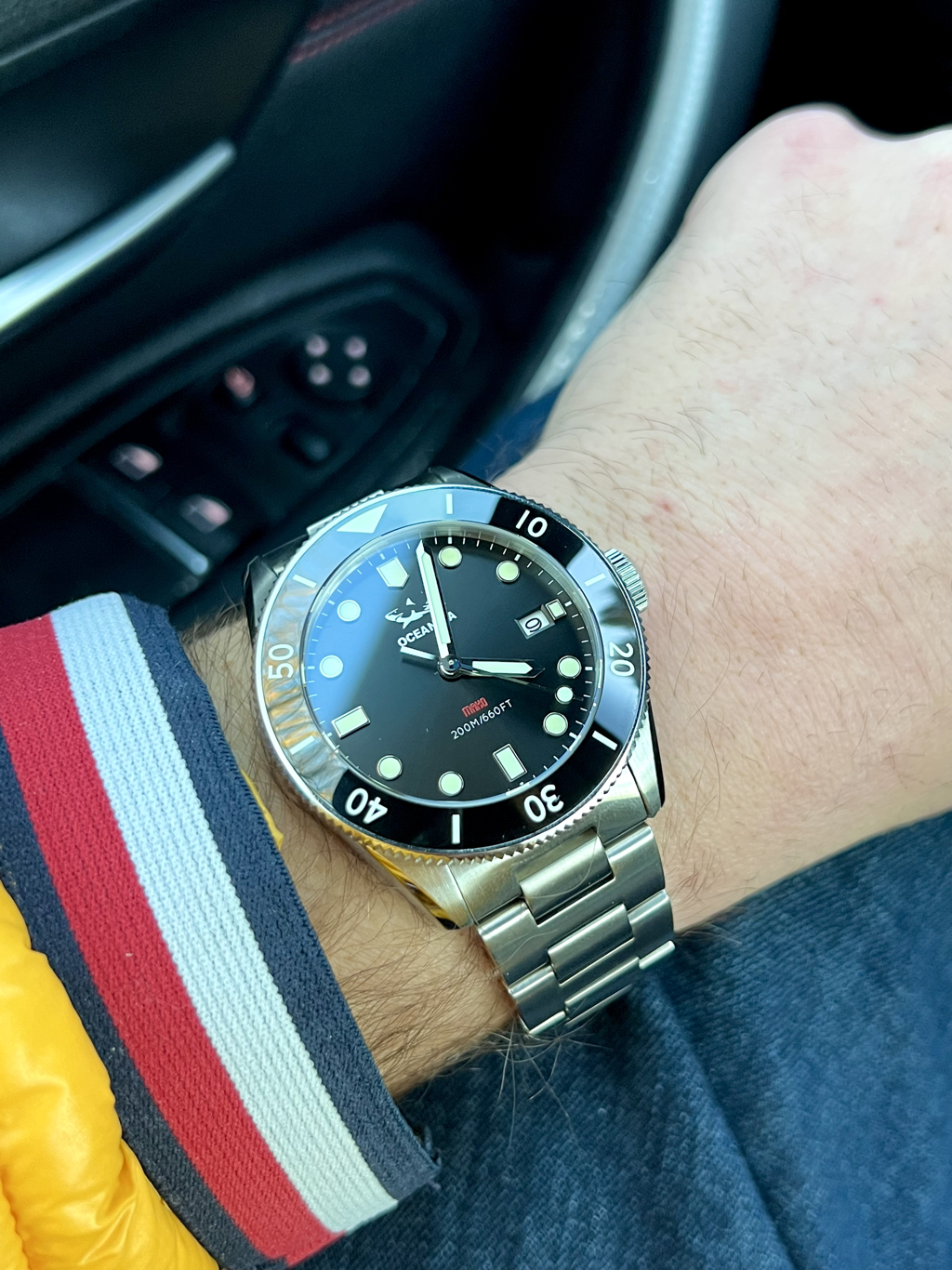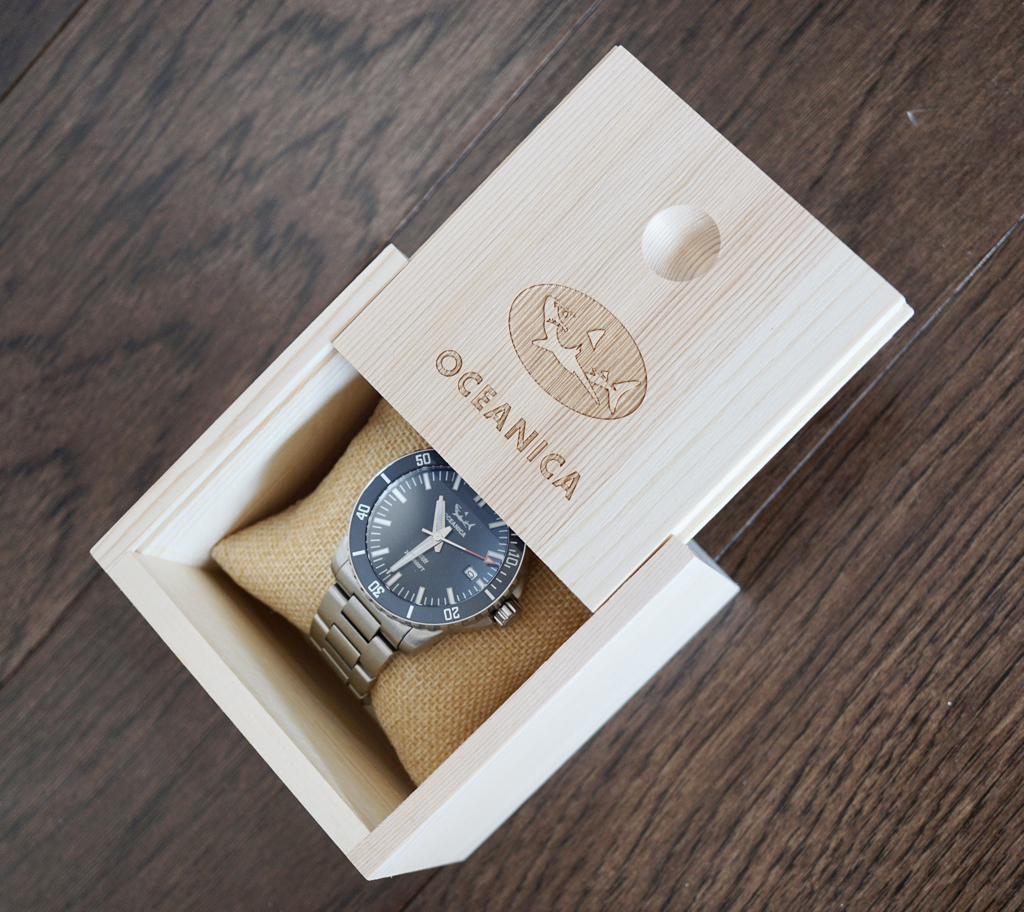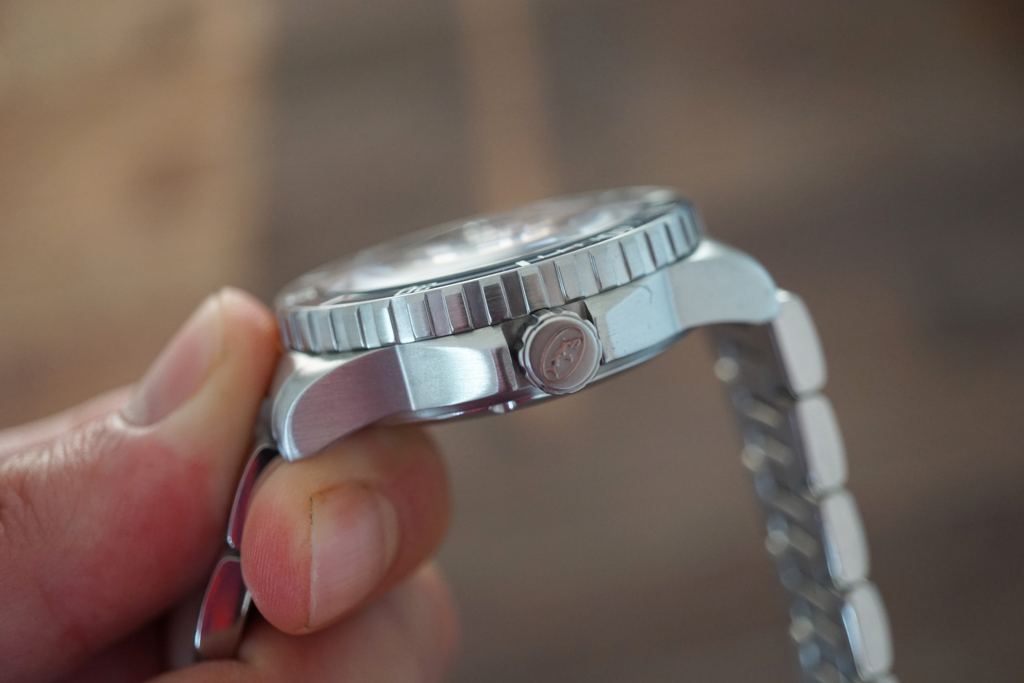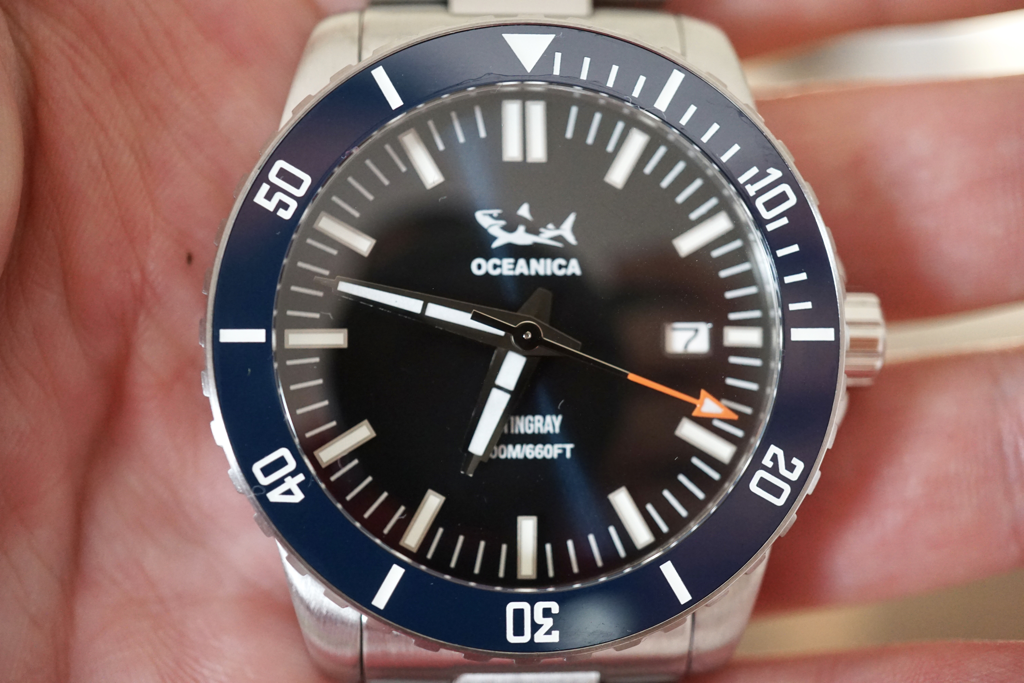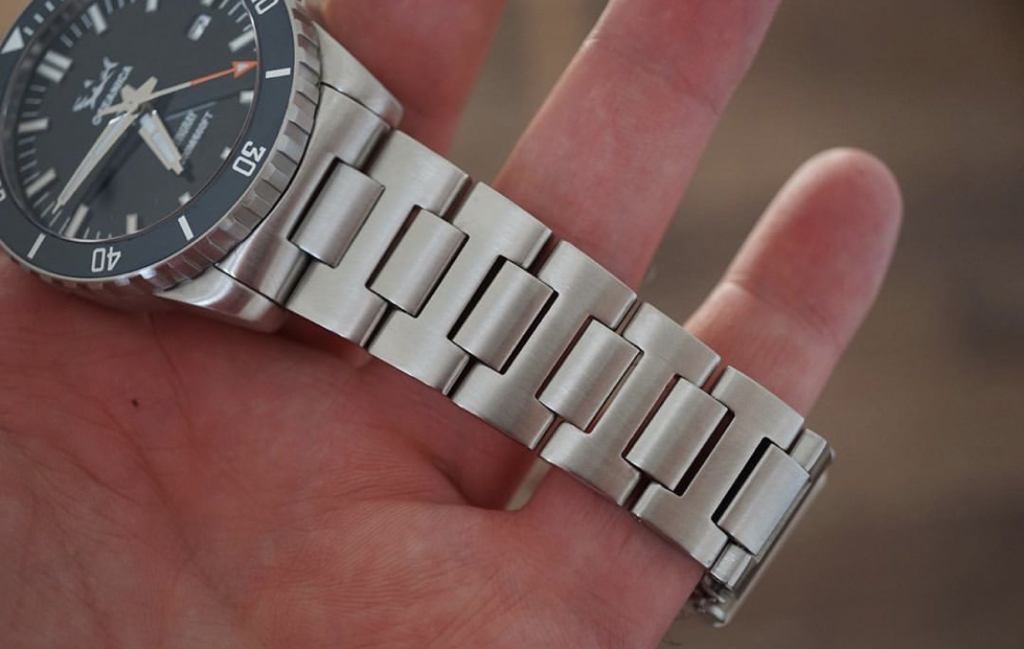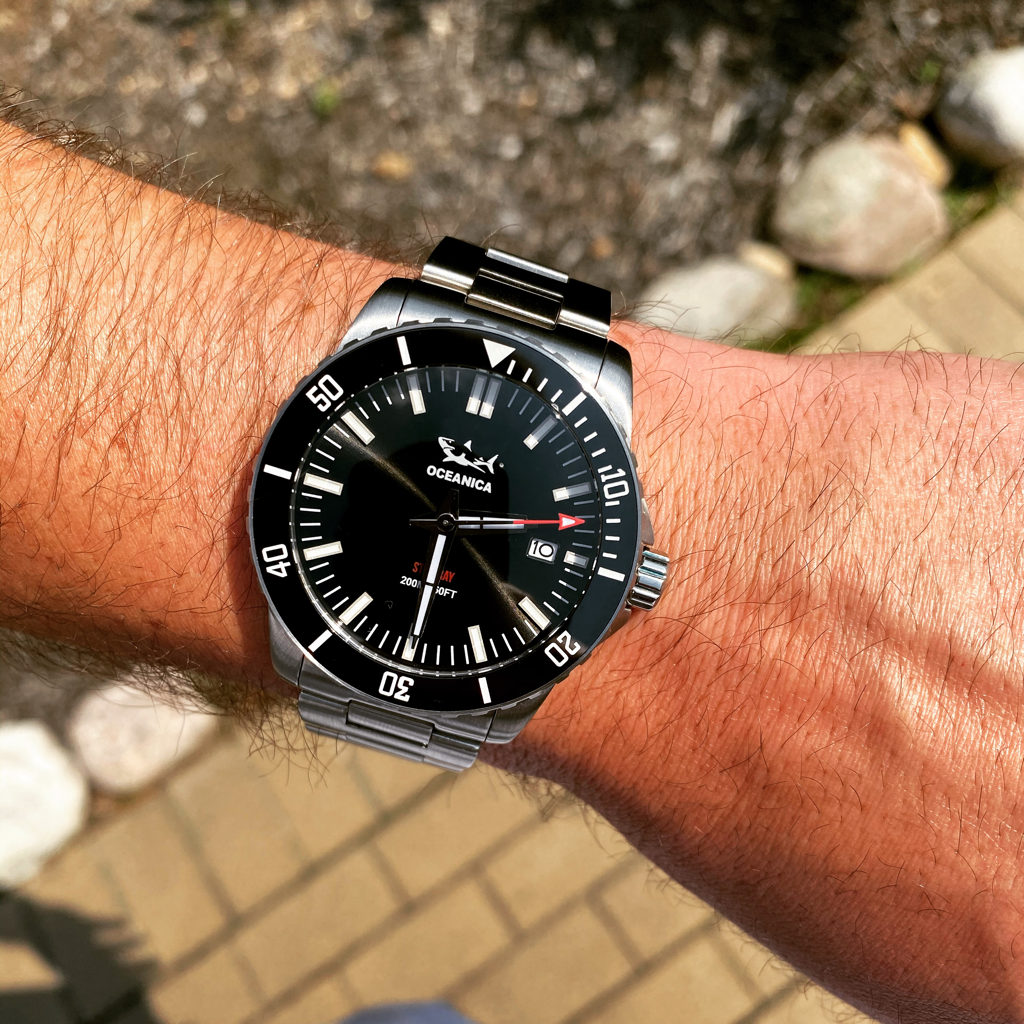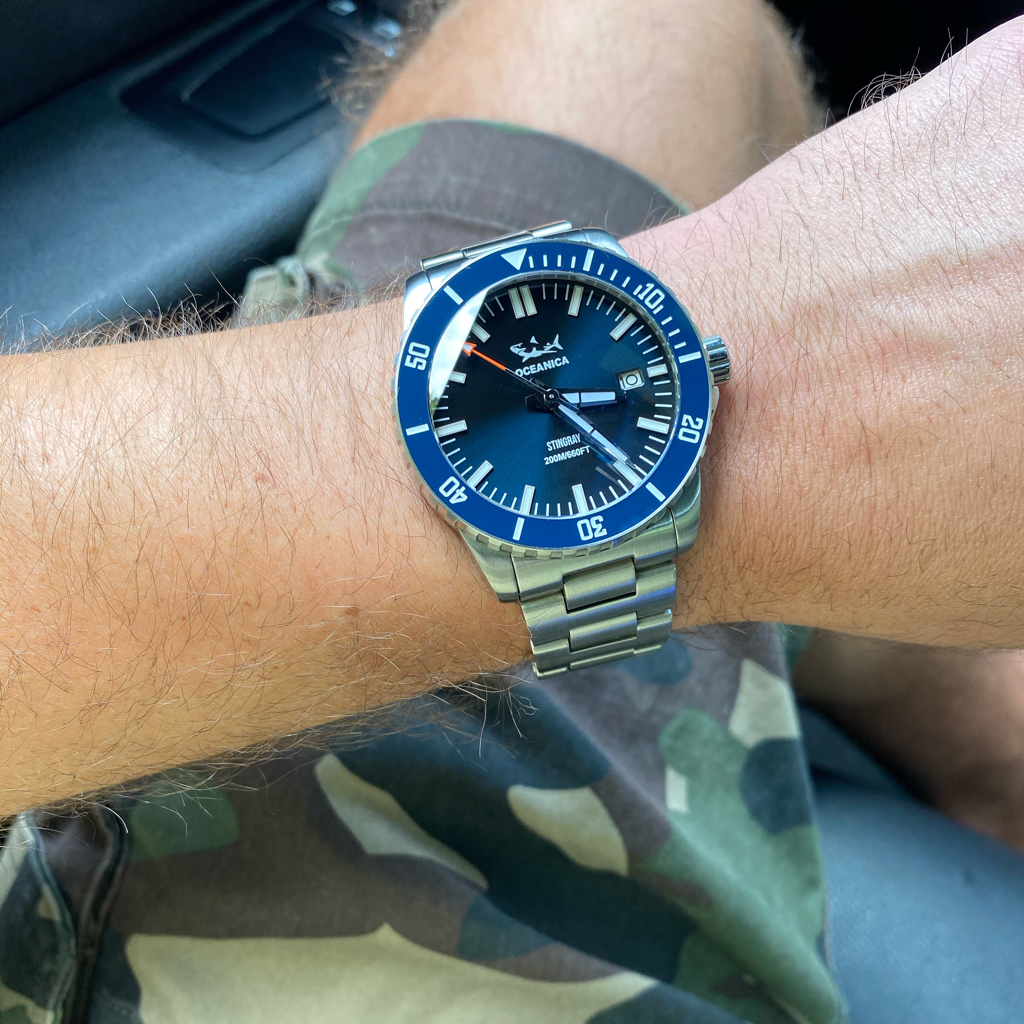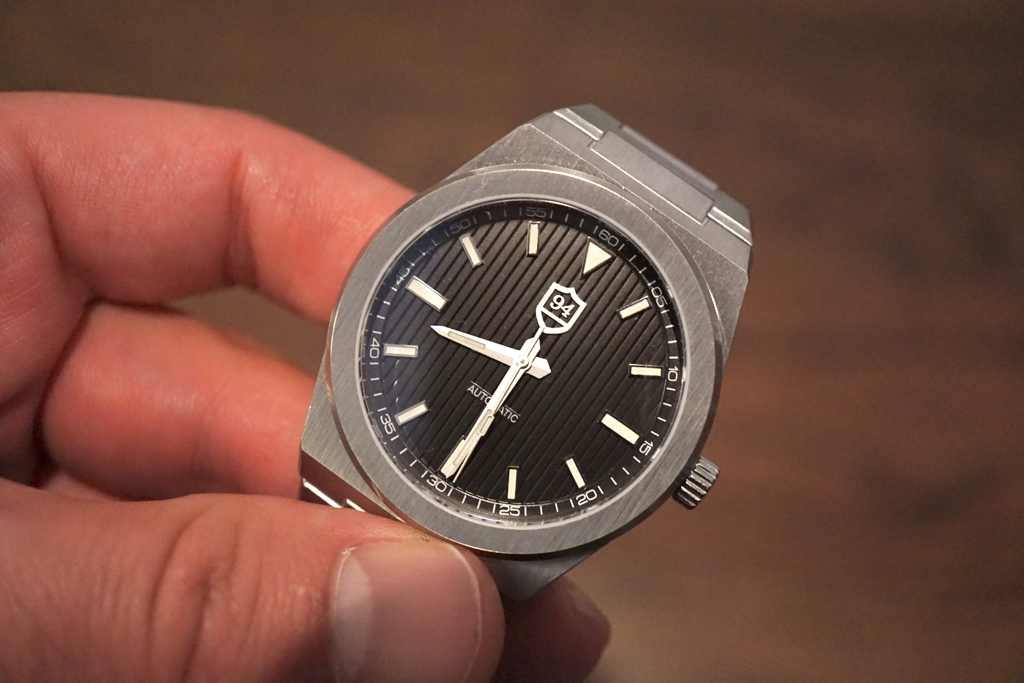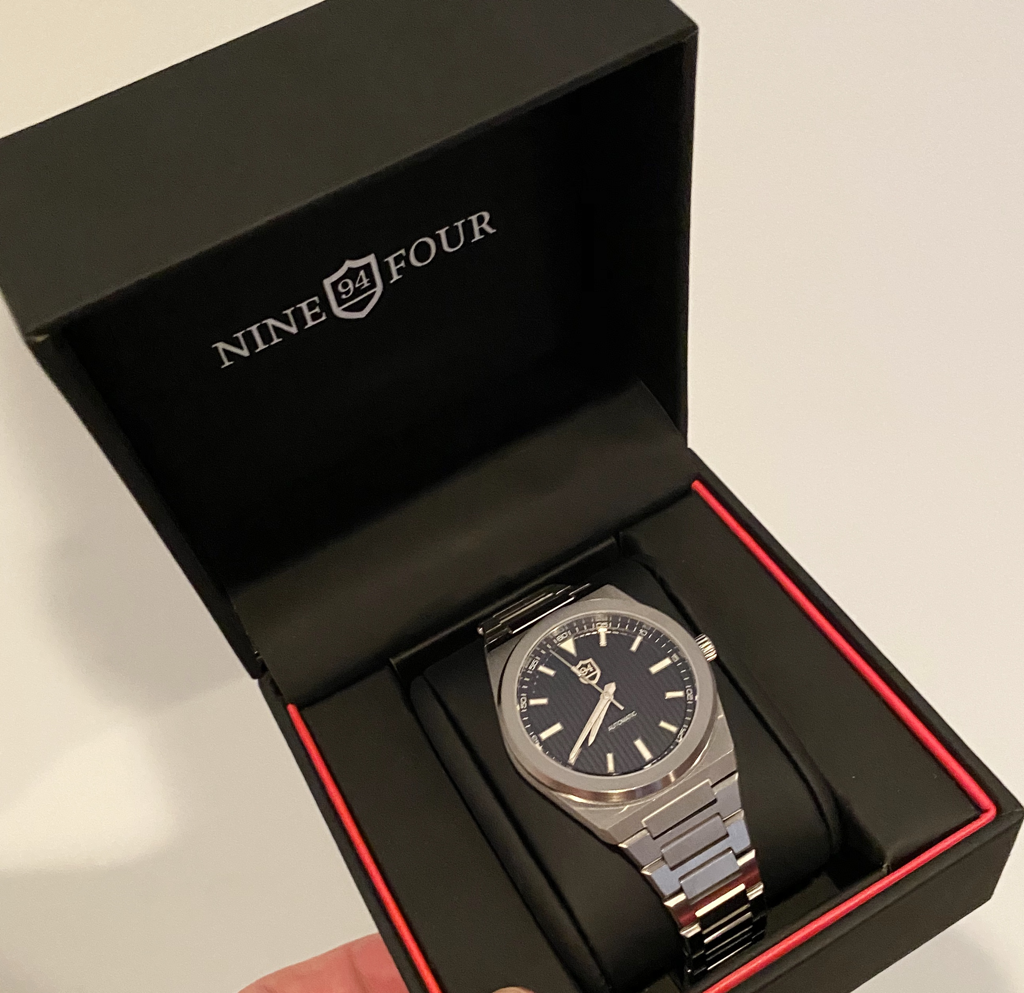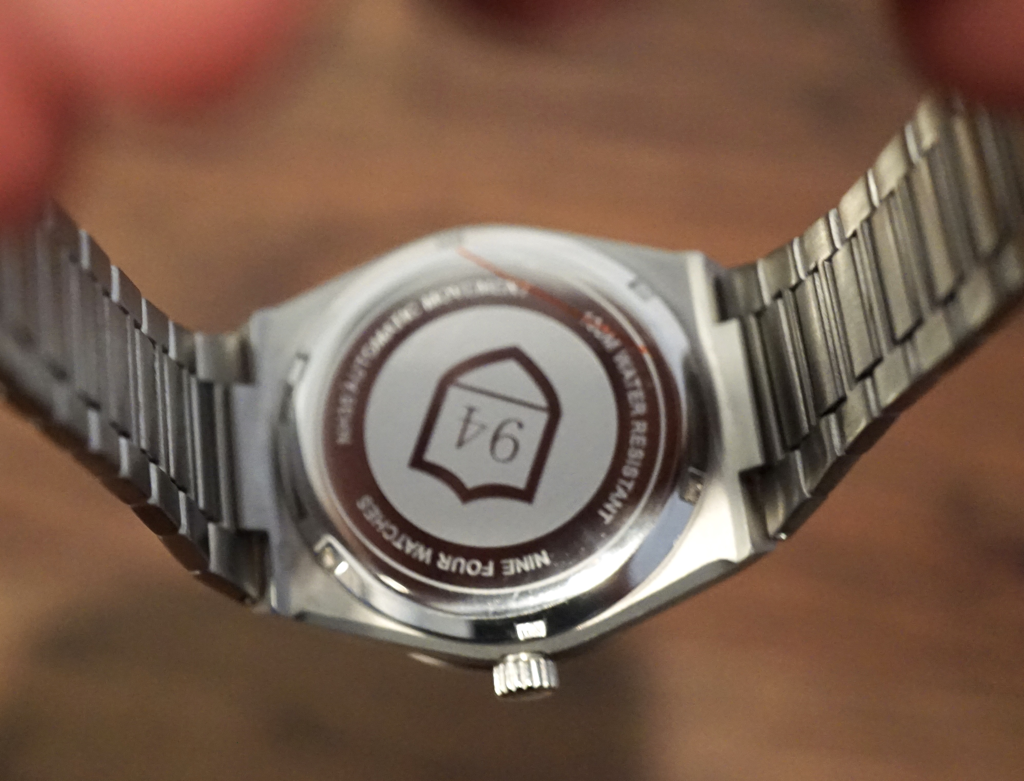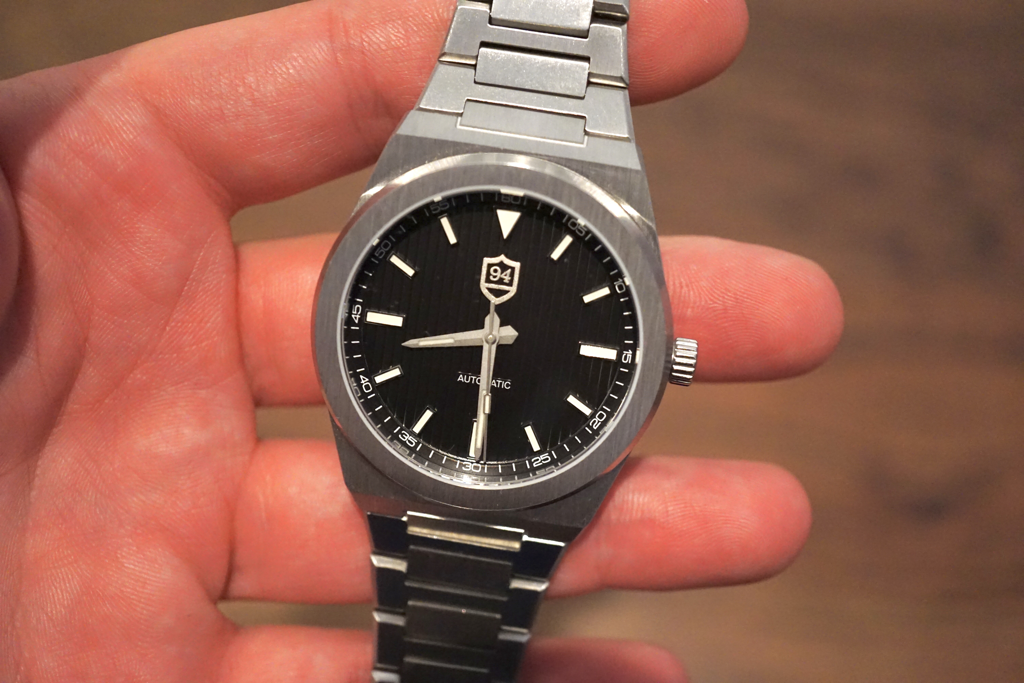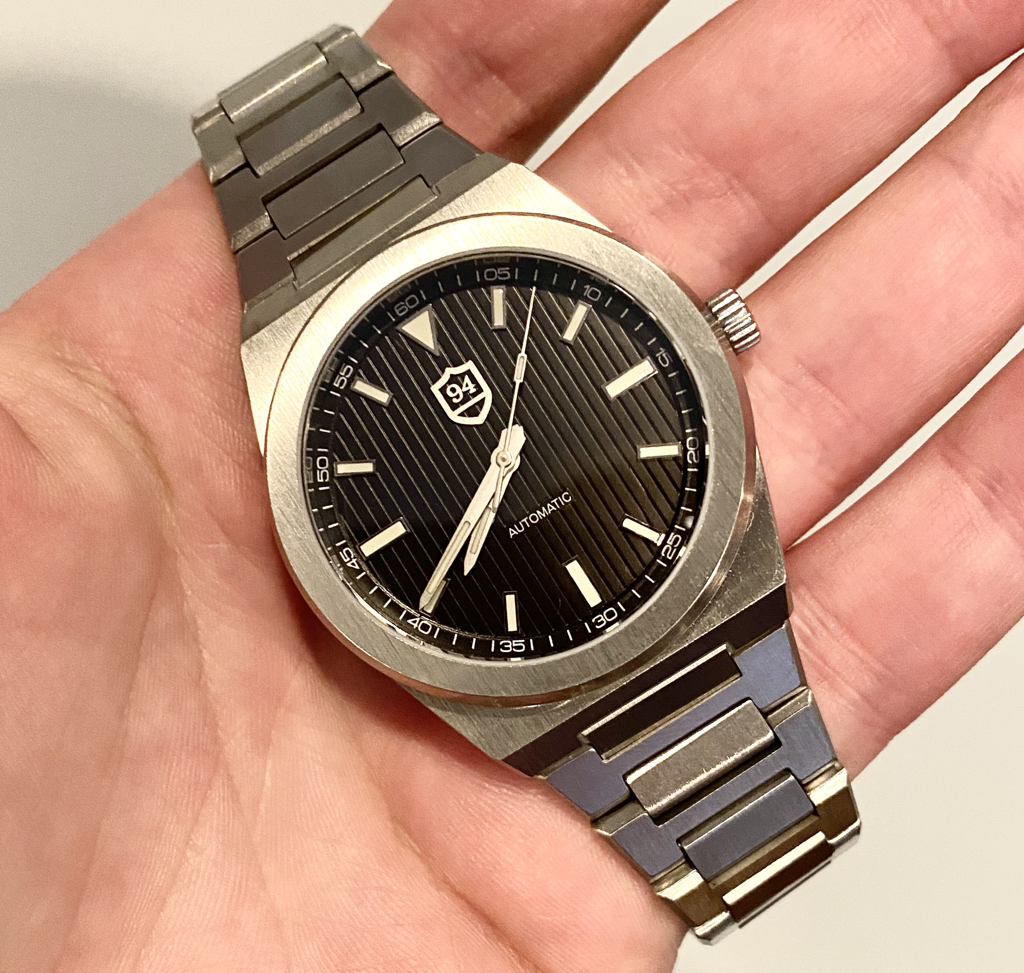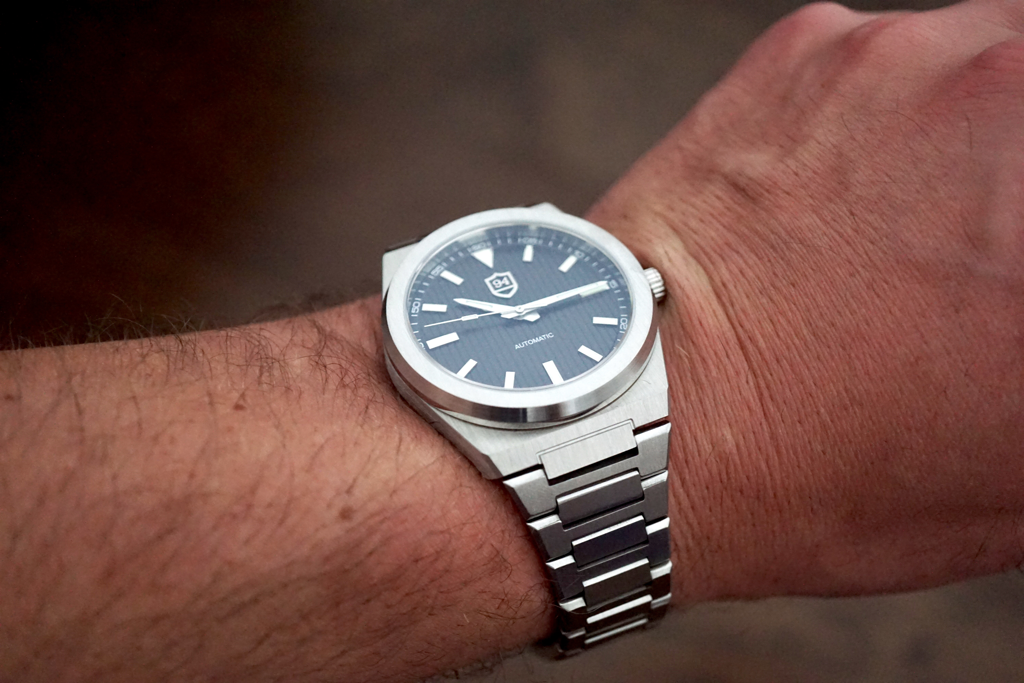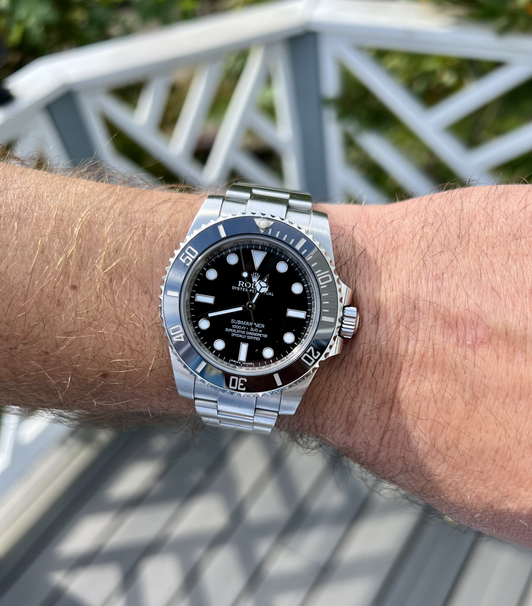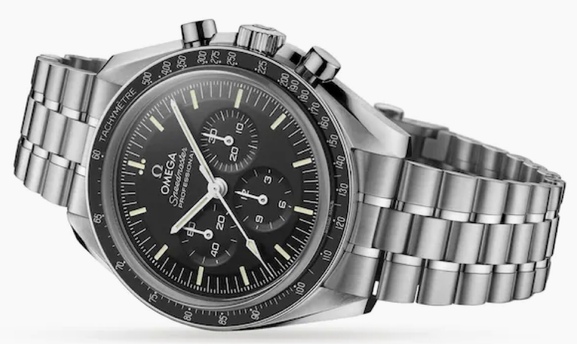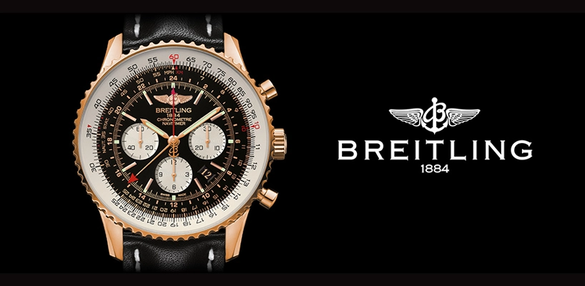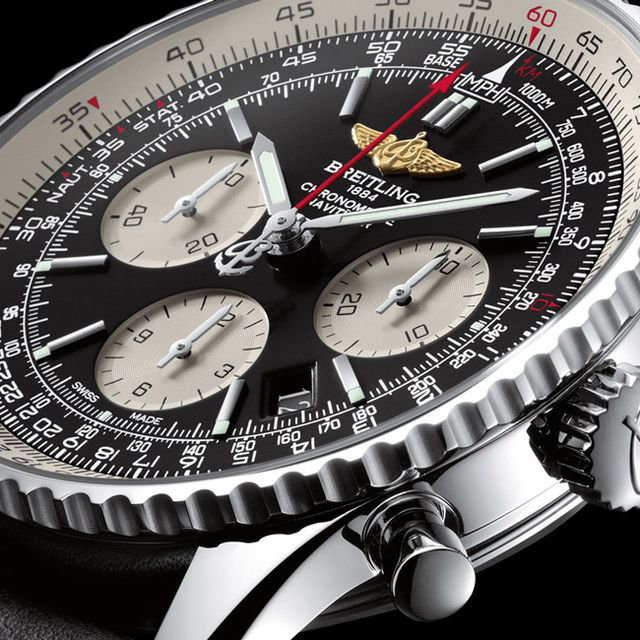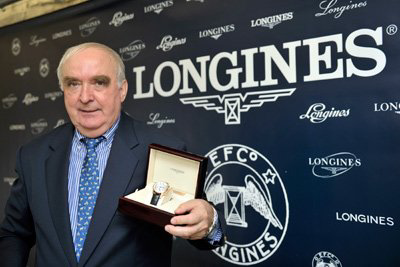CaseThe all new stunning and impressively built $239 Stingray is housed in a 41MM diameter stainless steel brushed case with 200M of water resistance making this one a true tool dive watch! It really is well finished and punches way above most other microbrands in terms of case quality, cut, and finishing. To my belief most brands with this type of quality charge upwards of $350 USD and up for this type of work, but not Oceanica, making this really a bargain. It is sad that most will never seem to realize that though! The lug to lug is 47MM whole the lugs are 22MM and the thickness at 12.5MM. One of the impressive areas is also the embossed custom designed by owner Caseback of a stingray swimming in the Ocean. It really is very detailed and perfect down to the details. The sides of the case are finely brushed with lug guards and a signed shark screw down crown. DialThere are two Sunburst dial options for the Stingray and possibly more if they reach 50,000 in funds. These are black and a nice blue which changes hues indoors and outdoors. The ceramic lumed 120 Click bezels are also very solid with satisfaction at each click and a luxury feel. The custom bezel contains good traction for your fingers at all angles, and easy to grip. The dial itself contains orange and red/white colours depending on the dial you choose and a nice arrow seconds hand. The indices themselves and hand applied and bordered with a polished silver border, making them pretty easy to read, as a diver should be. We get a domed sapphire crystal which feels tough, as the watch does with five layers of under anti reflective blue coating. Movement AutomaticThe seiko NH35A automatic movement is utilized here with a beat rate of 21,600 and 24 jewels. It has about a 40 hour power reserve when fully wound and also features hacking , self winding via crown. This is a well known movement and a tough robust one , a good choice for a tough automatic diver. Generally speakong these are usually accurate within 5-10 seconds a day and require little to no maintenance. H-Link Style BraceletI really dig this bracelet, its the same bracelet actually seen on some microbrands that charge around $600 for their watches which I find funny. The custom clasp contains six micro adjustments making it possible for a perfect fit without a quick adjust. The clasp also contains the oceanica logo and a flip over lock with two button eject. Its a comfortable bracelet , and even has solid end links which match the case perfectly. Adjusting this one was a breeze with screws on one side and I removed four links for my 6.5" wrist. ConclusionFurthermore, the STINGRAY definitely has features and characteristics seen at much much higher price ranges in microbrand watches. They honestly should
of charged atleast $300 for this one. Well, the value goes to the customer I assume! It really is a great looking multi situational diver which has superb qualities in every aspect. You wont find an area where they skimped on- The bracelet is stellar as well as the caseback and case / dial / lume. I think they knocked this onw out of the park and hope to see more from this young brand which emerged in 2018. If I were you I would reserve one on their Kickstarter as they usually sell out instantly or within days of releasing them on the website...from past experiences.
1 Comment
Today, we come back to the 94 SUCCESSOR , a watch we had the privilege of taking a look at during their prototype stage. The watch is now ready for sale and available via their webshop linked below. Let us see how it came out! |
Archives
February 2024
|
ROLEX HISTORY
Rolex is a Swiss luxury watch brand that was founded in 1905 by Hans Wilsdorf and Alfred Davis in London, England. The company originally began as Wilsdorf and Davis, but it was later renamed to Rolex in 1908.
The first Rolex watches were not manufactured in-house, but instead were made by other watchmakers and then branded with the Rolex name. However, Wilsdorf had a vision of creating a wristwatch that was both reliable and accurate, and he set out to develop his own movements.
In 1910, Rolex became the first wristwatch to receive the Swiss Certificate of Chronometric Precision, which was a testament to the accuracy of the watch. Over the years, Rolex continued to innovate and develop new technologies and features, such as the first waterproof wristwatch in 1926, the first self-winding mechanism in 1931, and the first wristwatch with a date display in 1945.
Rolex has also been associated with several famous individuals, including explorers, athletes, and celebrities. For example, Sir Edmund Hillary and Tenzing Norgay wore Rolex watches when they became the first people to reach the summit of Mount Everest in 1953. Rolex has also been the official timekeeper of several sporting events, including Wimbledon and the Formula 1 Grand Prix.
Today, Rolex is one of the most recognized and respected luxury watch brands in the world, known for its quality, precision, and timeless style.
The first Rolex watches were not manufactured in-house, but instead were made by other watchmakers and then branded with the Rolex name. However, Wilsdorf had a vision of creating a wristwatch that was both reliable and accurate, and he set out to develop his own movements.
In 1910, Rolex became the first wristwatch to receive the Swiss Certificate of Chronometric Precision, which was a testament to the accuracy of the watch. Over the years, Rolex continued to innovate and develop new technologies and features, such as the first waterproof wristwatch in 1926, the first self-winding mechanism in 1931, and the first wristwatch with a date display in 1945.
Rolex has also been associated with several famous individuals, including explorers, athletes, and celebrities. For example, Sir Edmund Hillary and Tenzing Norgay wore Rolex watches when they became the first people to reach the summit of Mount Everest in 1953. Rolex has also been the official timekeeper of several sporting events, including Wimbledon and the Formula 1 Grand Prix.
Today, Rolex is one of the most recognized and respected luxury watch brands in the world, known for its quality, precision, and timeless style.
OMEGA Watches History
Omega is a Swiss luxury watch brand founded in 1848 by Louis Brandt in La Chaux-de-Fonds, Switzerland. The brand initially operated under the name La Generale Watch Co. and produced pocket watches.
In 1894, Omega revolutionized the watch industry with the introduction of the 19-ligne Omega Calibre, which was more accurate and reliable than any other watch movement of the time. This innovation earned Omega numerous awards and accolades, and the brand quickly became known for its precision and quality.
In 1903, Omega was chosen as the official timekeeper for the Gordon Bennett Cup, an international balloon race. This marked the beginning of Omega's long-standing relationship with sports timing and its reputation as a reliable and accurate timekeeper.
In 1932, Omega became the first brand to be awarded the Olympic Cross of Merit for its outstanding contribution to sports timing at the Olympic Games. Since then, Omega has been the official timekeeper for numerous Olympic Games, and its timekeeping technology has continued to evolve and improve.
In the 1950s and 1960s, Omega's watches were worn by famous explorers and adventurers, including Sir Edmund Hillary and Tenzing Norgay during their ascent of Mount Everest in 1953, and Jacques Cousteau during his underwater expeditions.
In the 1960s, Omega introduced the Speedmaster, a chronograph watch that was originally designed for motorsports but became famous as the first watch worn on the moon during the Apollo 11 mission in 1969. The Speedmaster has since become one of Omega's most iconic and sought-after models.
Today, Omega continues to innovate and produce high-quality watches, including the Seamaster, Constellation, and De Ville collections. The brand also continues to be the official timekeeper for numerous sporting events, including the Olympic Games and the America's Cup.
In 1894, Omega revolutionized the watch industry with the introduction of the 19-ligne Omega Calibre, which was more accurate and reliable than any other watch movement of the time. This innovation earned Omega numerous awards and accolades, and the brand quickly became known for its precision and quality.
In 1903, Omega was chosen as the official timekeeper for the Gordon Bennett Cup, an international balloon race. This marked the beginning of Omega's long-standing relationship with sports timing and its reputation as a reliable and accurate timekeeper.
In 1932, Omega became the first brand to be awarded the Olympic Cross of Merit for its outstanding contribution to sports timing at the Olympic Games. Since then, Omega has been the official timekeeper for numerous Olympic Games, and its timekeeping technology has continued to evolve and improve.
In the 1950s and 1960s, Omega's watches were worn by famous explorers and adventurers, including Sir Edmund Hillary and Tenzing Norgay during their ascent of Mount Everest in 1953, and Jacques Cousteau during his underwater expeditions.
In the 1960s, Omega introduced the Speedmaster, a chronograph watch that was originally designed for motorsports but became famous as the first watch worn on the moon during the Apollo 11 mission in 1969. The Speedmaster has since become one of Omega's most iconic and sought-after models.
Today, Omega continues to innovate and produce high-quality watches, including the Seamaster, Constellation, and De Ville collections. The brand also continues to be the official timekeeper for numerous sporting events, including the Olympic Games and the America's Cup.
BREITLING Watches History
Breitling is a Swiss luxury watch brand that was founded in 1884 by Léon Breitling in the town of Saint-Imier in the Canton of Bern, Switzerland. Initially, the company specialized in producing chronographs and other precision timepieces for scientific and industrial purposes.
In 1915, Breitling introduced the first wrist-worn chronograph with a separate pusher to control the start, stop, and reset functions, which made it easier to use than previous models. This innovation helped establish Breitling as a leading maker of chronographs and other precision timepieces.
During the 1930s and 1940s, Breitling continued to innovate with the introduction of the first chronograph with a second independent pusher, which allowed for the recording of multiple elapsed times. The company also developed the Huit Aviation Department, which produced wristwatches for pilots and other aviation professionals.
In the 1950s, Breitling introduced the Navitimer, a wristwatch with a built-in slide rule that allowed pilots to perform complex calculations in-flight. The Navitimer became an instant classic and remains one of Breitling's most popular models to this day.
In the 1960s, Breitling continued to produce innovative timepieces, including the Chrono-Matic, which was the first automatic chronograph movement with a micro-rotor. The company also introduced the Emergency, a wristwatch with a built-in distress beacon that could be activated in case of an emergency.
In the years since, Breitling has continued to produce innovative and high-quality timepieces for a variety of applications, including aviation, diving, and sports. The company has also maintained a strong commitment to precision and accuracy, with many of its watches featuring COSC-certified movements. Today, Breitling is recognized as one of the world's leading luxury watch brands, with a reputation for innovation, quality, and style.
In 1915, Breitling introduced the first wrist-worn chronograph with a separate pusher to control the start, stop, and reset functions, which made it easier to use than previous models. This innovation helped establish Breitling as a leading maker of chronographs and other precision timepieces.
During the 1930s and 1940s, Breitling continued to innovate with the introduction of the first chronograph with a second independent pusher, which allowed for the recording of multiple elapsed times. The company also developed the Huit Aviation Department, which produced wristwatches for pilots and other aviation professionals.
In the 1950s, Breitling introduced the Navitimer, a wristwatch with a built-in slide rule that allowed pilots to perform complex calculations in-flight. The Navitimer became an instant classic and remains one of Breitling's most popular models to this day.
In the 1960s, Breitling continued to produce innovative timepieces, including the Chrono-Matic, which was the first automatic chronograph movement with a micro-rotor. The company also introduced the Emergency, a wristwatch with a built-in distress beacon that could be activated in case of an emergency.
In the years since, Breitling has continued to produce innovative and high-quality timepieces for a variety of applications, including aviation, diving, and sports. The company has also maintained a strong commitment to precision and accuracy, with many of its watches featuring COSC-certified movements. Today, Breitling is recognized as one of the world's leading luxury watch brands, with a reputation for innovation, quality, and style.
Longines
Longines is a Swiss luxury watch company that was founded in 1832 by Auguste Agassiz in the town of Saint-Imier, Switzerland. The company has a long and prestigious history in the world of watchmaking, and has been responsible for many innovations and milestones in the industry.
In the early days, Longines primarily produced pocket watches, and quickly gained a reputation for precision and accuracy. By the end of the 19th century, Longines had become one of the leading watchmakers in the world. In 1912, the company introduced the first chronograph wristwatch, which was quickly adopted by the military and aviation communities.
In the 1920s and 1930s, Longines continued to innovate with the introduction of the world's first quartz clock and the first wristwatch with an automatic winding mechanism. During World War II, Longines produced wristwatches for the British Royal Air Force, and continued to produce military watches for several decades afterwards.
In the post-war years, Longines became known for its elegant and sophisticated watches, particularly its "Conquest" line of watches. In the 1950s and 1960s, Longines was a favorite of celebrities and politicians, and its watches were frequently seen on the wrists of Elvis Presley, John F. Kennedy, and other famous figures.
In recent years, Longines has continued to produce high-quality watches that combine traditional Swiss craftsmanship with modern technology. The company is particularly known for its sport watches, including its "HydroConquest" line of diving watches and its "Conquest Classic" line of chronographs.
Today, Longines is owned by the Swatch Group, and remains a leading brand in the luxury watch industry. Its watches are prized for their precision, reliability, and timeless style.
In the early days, Longines primarily produced pocket watches, and quickly gained a reputation for precision and accuracy. By the end of the 19th century, Longines had become one of the leading watchmakers in the world. In 1912, the company introduced the first chronograph wristwatch, which was quickly adopted by the military and aviation communities.
In the 1920s and 1930s, Longines continued to innovate with the introduction of the world's first quartz clock and the first wristwatch with an automatic winding mechanism. During World War II, Longines produced wristwatches for the British Royal Air Force, and continued to produce military watches for several decades afterwards.
In the post-war years, Longines became known for its elegant and sophisticated watches, particularly its "Conquest" line of watches. In the 1950s and 1960s, Longines was a favorite of celebrities and politicians, and its watches were frequently seen on the wrists of Elvis Presley, John F. Kennedy, and other famous figures.
In recent years, Longines has continued to produce high-quality watches that combine traditional Swiss craftsmanship with modern technology. The company is particularly known for its sport watches, including its "HydroConquest" line of diving watches and its "Conquest Classic" line of chronographs.
Today, Longines is owned by the Swatch Group, and remains a leading brand in the luxury watch industry. Its watches are prized for their precision, reliability, and timeless style.
Tissot
Tissot is a Swiss watch brand that was founded in 1853 by Charles-Félicien Tissot and his son Charles-Émile Tissot in the town of Le Locle, Switzerland. The company has a long and rich history in the world of watchmaking, and has been responsible for many innovations and milestones in the industry.
In the early days, Tissot primarily produced pocket watches, and quickly gained a reputation for quality and precision. By the end of the 19th century, Tissot was one of the largest watchmakers in Switzerland, and was exporting its watches to countries around the world.
In the early 20th century, Tissot continued to innovate with the introduction of the first non-magnetic wristwatch, the first dual time-zone watch, and the first watch with a plastic case. During World War II, Tissot produced watches for the Allied forces, and continued to produce military watches for several decades afterwards.
In the post-war years, Tissot became known for its elegant and sophisticated watches, particularly its "Tissot Visodate" line of watches, which featured a date function and a distinctive "T" logo on the dial. In the 1970s, Tissot was one of the first Swiss watch brands to introduce quartz watches, which quickly became popular due to their accuracy and affordability.
In recent years, Tissot has continued to produce high-quality watches that combine traditional Swiss craftsmanship with modern technology. The company is particularly known for its sport watches, including its "T-Touch" line of watches, which feature touch-screen technology and a range of functions such as altimeter, compass, and thermometer.
Today, Tissot is part of the Swatch Group, and remains a leading brand in the watch industry. Its watches are prized for their quality, durability, and stylish design, and are worn by watch enthusiasts and collectors around the world.
In the early days, Tissot primarily produced pocket watches, and quickly gained a reputation for quality and precision. By the end of the 19th century, Tissot was one of the largest watchmakers in Switzerland, and was exporting its watches to countries around the world.
In the early 20th century, Tissot continued to innovate with the introduction of the first non-magnetic wristwatch, the first dual time-zone watch, and the first watch with a plastic case. During World War II, Tissot produced watches for the Allied forces, and continued to produce military watches for several decades afterwards.
In the post-war years, Tissot became known for its elegant and sophisticated watches, particularly its "Tissot Visodate" line of watches, which featured a date function and a distinctive "T" logo on the dial. In the 1970s, Tissot was one of the first Swiss watch brands to introduce quartz watches, which quickly became popular due to their accuracy and affordability.
In recent years, Tissot has continued to produce high-quality watches that combine traditional Swiss craftsmanship with modern technology. The company is particularly known for its sport watches, including its "T-Touch" line of watches, which feature touch-screen technology and a range of functions such as altimeter, compass, and thermometer.
Today, Tissot is part of the Swatch Group, and remains a leading brand in the watch industry. Its watches are prized for their quality, durability, and stylish design, and are worn by watch enthusiasts and collectors around the world.


